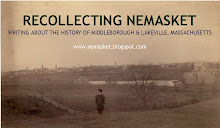.
Throughout its operation, the Green School relied upon a number of sources for textbooks, including Ginn & Co.; American Book Co.; Thompson, Brown & Co.; George F. King & Merrill, and several others. Textbooks were employed by the older students only. “Books are not needed” for younger pupils, wrote Middleborough Superintendent of Schools Willard T. Leonard in 1891, “for all teaching is from the blackboard.”
Initially, students were required to purchase the books which the town was required to make available to them. By 1880, “all the common school books used in the schools are now provided by the town, as required, and are kept for sale at as near the wholesale prices as can be, without incurring actual loss. These books are sold at the stores of John Shaw, and Shaw & Childs.” While the school committee recognized by the mid-1880s its obligation to ultimately purchase textbooks, “one for each scholar”, as per the law requiring free textbooks which was implemented in August, 1884, it also sought to keep school expenses to a minimum and “furnished only what we were absolutely obliged to provide by law, requiring pupils to use whatever supplies they might have on hand.” When the School Committee replaced the “obsolete” Progressive Speller in 1881 with Worcester’s Speller, it boasted that it had “been able to do [so] without any expense whatever, either to the town or pupils”, a frequent rationale behind the local committee's decisions. Increasingly, however, the town recognized the benefits of purchasing and furnishing its own books to students, despite the expected lifetime of each book was estimated in 1885 at only three years.
Occasionally, students could make use of worn and out-dated textbooks. During the First World War due to the scarcity of paper, Green School students were able to sell worn out and discarded textbooks to a junk dealer for enough money to purchase a large dictionary for the school.
In combination with text books, various study aids were helpful in instructing students and over time, the Green schoolhouse came to be filled with these aids which were acquired from the town, donated by generous residents within the district, purchased by the students through fund-raising efforts, or won in various contests. One of the earliest aids mentioned in the Green School was a globe acquired from Ginn, Heath & Company in 1881, when similar globes were supplied to all the local schools. The globe was considered invaluable in providing “a more exact understanding of geography.” In 1887, the school was also furnished with "good" maps which were up to date.
In 1905, the Green was equipped with an outfit “for busy work for pupils of the primary grades" and the following year in 1906 acquired a Webster’s Unabridged Dictionary and a Twentieth Century Atlas. By 1924, the town was able to pride itself on the amount of supplementary materials to which suburban school teachers had access. “Out-of-town teachers visiting our schools comment on the amount of material the teachers have to work with. It is essential for good schools that they be thus equipped. It is doubtful if any system of one-romm schools in the state is so well supplied with educational aids as the rural schools of our town. The past year maps, charts, supplementary educational work for self-supervised study have been placed in these schools.” Among these last mentioned aids were blackboard charts for penmanship.
Subscribe to:
Post Comments (Atom)













+-+Copy.jpg)

+of+Smoky+Mountains+018.jpg)

No comments:
Post a Comment